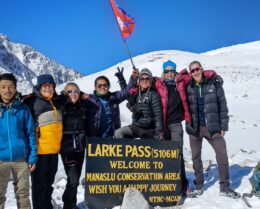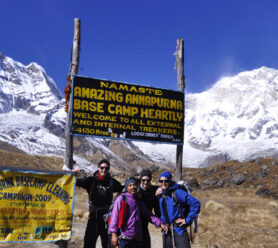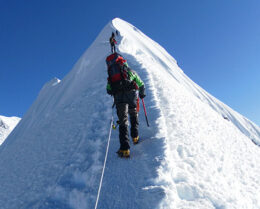Annapurna Base Camp Trek in March
UPDATED ON 21 January, 2024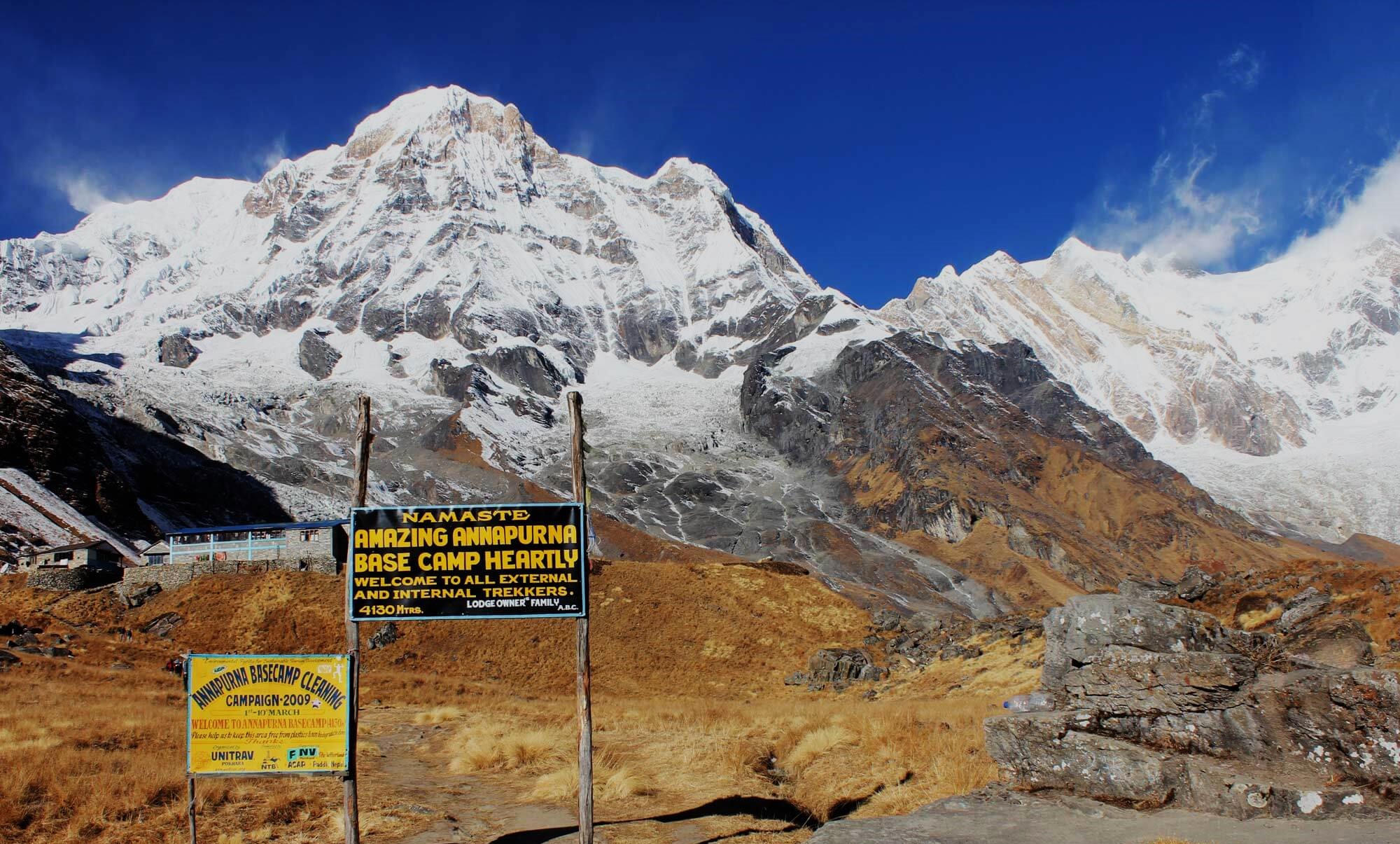
The Annapurna Base Camp Trek in March offers a picturesque view of the elegant Annapurna mountain range beneath the clear blue sky. The amazing beauty of the Annapurna Base Camp Trek never fails to enthrall visitors. Annapurna Base Camp is 4,130 meters above sea level. In March when the dazzling springtime light adds to the Annapurna region’s already breathtaking splendor, leaving trekkers even more enthralled.
March brings with it the rush and bustle of trekkers, mules, and porters after the winter off-season, with the deserted and empty trekking trails. Green grasses and weeds start to appear in the Annapurna mountain’s foothills. The sound of tweeting birds and meandering creatures fills the lush, deep forests.
In addition, as they rise upward toward the base of the mountain, people will dance due to the pleasant weather and clear skies. So, are you prepared to dance and spin about the Annapurna region to the beat of the March harmony?
Annapurna Base Camp Trek in March Highlights
- Explore the distinct customs, heritage, and warmth of the Gurung and Sherpa communities all while experiencing the fusion of Buddhism and Hinduism.
- sweeping views of Dhaulagiri, Pisang Peak, Gangapurna, Manaslu, and the Annapurna massifs.
- Walking through the verdant oak and rhododendron forest.
- Beautiful view of the sun setting and rising.
- A glimpse into the simple, traditional way of life in Nepal.
- Explore the Annapurna Conservation Area on foot.
- Bathing in relief at the Jhinu Danda Hot Springs.
Outline Itinerary
Day 1: Journey to Kathmandu (1,345 meters/4,411ft) and check in to the hotel.
Day 2: Touring Kathmandu and having a welcome meal and conversation.
Day 3: Travel by car to Pokhara, then hike (2,012 m/6,363ft) to Ghandruk.
Day 4: Trek to Chhomrong (2,340m/7,675ft).
Day 5: Hike (2,335m/7,658 ft) from Chhomrong to Bamboo
Day 6: Hike from Bamboo to the Himalaya Hotel (9,577 feet/2,920 meters)
Day 7: Hike from Himalaya Hotel to Machhapuchhre Base Camp (3,700m/12,136ft) to Annapurna Base Camp (4,130m/1,3546ft)
Day 8: Return the trek (2,335m/7,658 ft) to Bamboo
Day 9: Hike to Jhinu Danda Hot Spring (1,610 meters/5,280 feet)
Day 10: Return to Pokhara by jeep after trekking to Sauli Bazaar.
Day 11: Return to Kathmandu by car.
Trek Grade
The Annapurna Base Camp trek is regarded as a moderate-level trip that can take you to 4,130 meters, or 13,549 feet, above sea level. The Annapurna base camp trip will take you around 115 kilometers in total. It will therefore take you six to seven hours of hiking per day to cover the approximate distance of 15 km.
Even if your journey won’t be hindered by any technical issues, you’ll still need to put in a lot of work and perseverance to navigate through challenging terrain and ascend high slopes on the mountainous trail. Walking these large distances will also be exhausting, but March’s consistent weather and vibrant scenery will make you feel more energized for the adventure.
Weather and Climate
In Nepal, March marks the start of the blossoming spring season. In the lower Annapurna region, the average temperature ranges from -2 to 21 degrees Celsius as spring arrives in March after a bitterly cold and snowy winter. There will be a temperature decrease the higher you get. The temperature in the Annapurna region varies from -16 to 10 degrees Celsius due to its higher altitude. While the night and morning will still be rather chilly, the days are starting to get warmer.
Since the monsoon season is still many weeks away in March, there is essentially no chance of precipitation when the weather shifts from dry, frigid conditions to springtime. In the years before, the percentage of precipitation ranged from 39% to 42%. Up to mid-March, there may be sporadic, unpredictable snowfalls at higher elevations.
Why Annapurna Base Camp in March?
March Madness: Weather Delight
- Daytime temperatures will rise significantly as the temperature steadily rises. There will be more daylight during the day, about seven hours. You will have more time as a result to see the Annapurna region at your leisure.
- You can forget about your hike exhaustion after a strenuous day of hiking by taking in the refreshing breeze. Furthermore, there will still be snowfall in the valleys and on the paths, which will enhance the purity of the Annapurna base camp trek in March.
Similarly, the warm sunlight starts to melt the snow, causing the streams and waterfalls on the glaciers to flow more quickly. You’ll feel closer to nature as a result of all the natural magic experienced throughout the March.
Symphony of Beauty: Exploring the Mountain Vistas and Valleys of the Annapurna Region
This time of year, the sky is typically clear and displays a striking shade of blue. Additionally, as visibility rises, breathtaking views of the Himalayan peaks, such as Gangapurna, Hiunchuli, Annapurna I–IV, and Machhapuchchhre, are available. It is best to see the expansive mountains early in the morning, though, as clouds and haze can occasionally obscure the vistas when the weather at higher elevations turns severe.
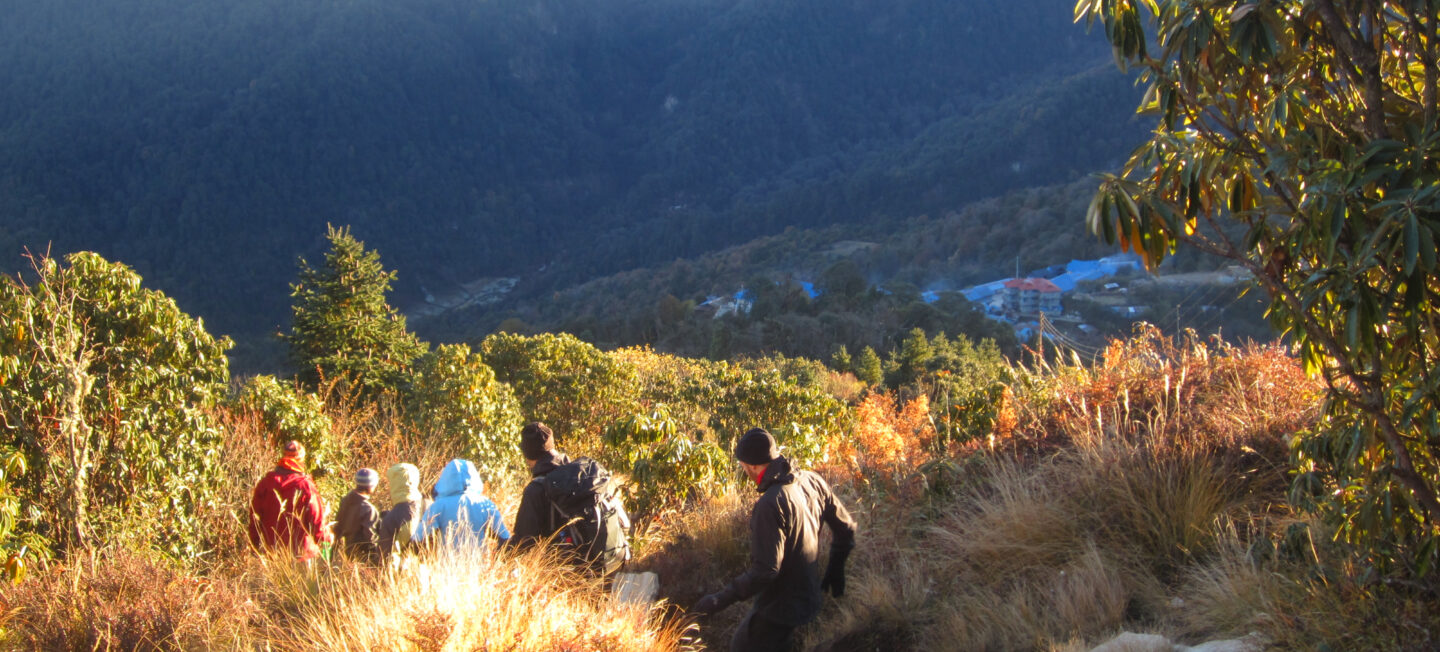
From Rhododendrons to Orchids: Floral Charm
When spring finally arrives, the air is filled with vivid color that contrasts with the whiteness of the winter snow. The return of the verdant forests will provide a striking contrast to the many tones of the rhododendron blooms.
In addition, a carpet of beauty is created by the petals of various wildflowers, including Arenaria Glanduligera, Waldheimia Glabra, primulas, and orchids, which are strewn over the paths. The vivid hues of wildflowers serve as a kind of color light that enlivens the surrounding area.
The terrain transforms into shrublands and alpine meadows as you ascend higher in altitude. Unusual alpine flora that have adapted to the harsh mountain environment will be encountered. Additionally, you can see how lichens, mosses, and small plants are scattered across the rocky ground as bryophytes.
This demonstrates nature’s adaptability and persistence and helps you appreciate the constant effort people put forth to achieve their goals in life.
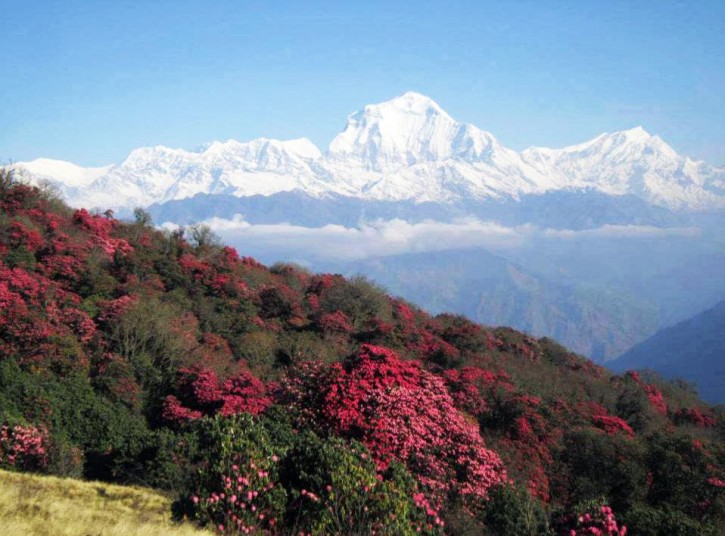
Ecological Marvels: Introduction to Biodiversity
When trekking through the Annapurna protection region in March, you could see a wide variety of species. This includes animals like the Eurasian Otter, Himalayan/Asiatic Black Bear, Jungle Cat, and others, as well as birds like the Himalayan Monal, Satyr Tragopan, Black-headed Shrike Babbler, and Blood Pheasant.
March hikes to Annapurna Base Camp provide opportunities to see vibrant butterflies, bees, and beetles, all of which contribute to the area’s natural splendor. Even though they are rare, endangered animals like red pandas and snow leopards enhance the fun and excitement of learning about the local biodiversity. Additionally, conservation zones shorten their grasslands to improve your view of the rhinos.
Dancing to the Rhythm: Festivals Reflecting Cultures and Traditions
Walking to Annapurna Base Camp in March, when Holi and Lhosar are celebrated, is a once-in-a-lifetime chance to get fully immersed in the native way of life and see the festivities.
Participate in cultural processions, experience traditional dances, and savor native cuisine. Enhance your trek with cultural immersion, creating lasting memories at Annapurna Base Camp. Build relationships with locals for a richer travel experience.
Escape the Crowd: Enjoy Every Moment
The routes leading up to Annapurna Base Camp will be quiet and uncrowded in early March because of the lingering mild weather. You’ll be able to take in the beauty at your leisure because of this. Furthermore, you can take flawless photos without waiting for people to disappear into the background.
Annapurna Base Camp in March Difficulty
Although there is nothing especially tough about the moderately difficult journey, the steep and rough terrain does add a little bit to the difficulty of the Annapurna base camp walk.
Additionally, you will be ascending to a height of 4,130 meters, which increases the likelihood that you will have altitude sickness. If you fail to acclimate your body adequately, this likelihood may rise. As a result, you must walk at your own pace and stop sometimes if you get dyspnea to avoid altitude sickness.
Moreover, prolonged hiking sessions may leave you wanting to never go trekking again. Feelings such as “Why am I doing this to myself?” can occur. As a result, you must get enough sleep to enjoy the entire journey and avoid overtaxing your body.
Are Permits Required for Trekking to Annapurna Base Camp?
Trekking is considered to necessitate thorough planning in large part because some locations cannot be entered without evidence of identity or other forms of documents. The Annapurna base camp hike also requires two permits to finish.
The first permit you must obtain is the Annapurna Conservation Area Permit (ACAP), as the Annapurna base camp is governed by the Annapurna Conservation Area.
Cost of ACAP
Another document you’ll need isn’t so much a permit as it’s mandatory paperwork for all trekking. The “Trekkers Information Management System (TIMS)” has been put into place by the Nepal Tourism Board and Trekking Agencies Association to ensure the security and safety of trekkers.
Cost of TIMS card
- For overseas citizens participating in group treks: Rs. 1000 per person, or roughly $10.
- Regarding foreign nationals who are independent hikers: Rs. 2,000 for each individual
- For citizens of SAARC who go on group treks: each individual, Rs. 300
- Regarding SAARC nationals who are independent hikers: 600 rupees for each individual
- You can get these cards from Pokhara or Kathmandu, depending on which location is most convenient for you.
What Are the Necessary Preparations for the Annapurna Base Camp Trek in March?
When someone shares their hiking experience and explains how difficult it was for them and why they returned halfway through, it might make you feel burdened. However, keep in mind that each person is unique.
In addition, the Annapurna base camp trip in March has a success record of 98% to 100% and just requires a minimum degree of physical and mental fitness. This is a trek that even inexperienced hikers can easily finish. March will be more comfortable for hikers because there are no problems with the weather or trails.
Even though you may be suspicious of other people’s experiences, it’s always preferable to be prepared for the trip. Thus, you can attempt physical activity or go hiking at a high altitude. In addition, to increase your stamina, consider cardiovascular exercises like swimming, jogging, and walking.
To avoid being overly anxious or panicked during the hike, you need also be psychologically ready for extended hiking days and flexible in unforeseen circumstances.
Packing Right: Necessities
Carrying as little as possible is usually advised, but don’t forget to include the necessities. Furthermore, because it is crucial to be prepared for all eventualities, the packing lists for the Annapurna base camp do not significantly change depending on the season. Please feel free to check this reference if you think you are missing something.
Accommodations and Foods along the Annapurna Base Camp Trek in March
March is the busiest month in spring for the Annapurna base camp trek, therefore you can expect excellent facilities and services since the teahouses and lodges are filled.
Accommodations

The typical lodging options for those doing the Annapurna base camp trek include teahouses and lodges. Usually, these teahouses have a twin-sharing room with cushions, mattresses, and blankets. While some tea houses have their bathrooms, others must use the common restroom nearby.
Additionally, teahouses include communal dining areas and fireplaces where you can meet and greet with other hikers.
Food
The Annapurna base camp trek, one of the most popular trekking routes in Nepal, allows you to sample a variety of cuisines, including local fare, Indian and Tibetan specialties, foreign cuisines, and most importantly, traditional Nepali cuisine. Veg, non-vegetarian, and vegan alternatives will be available in the teahouses.
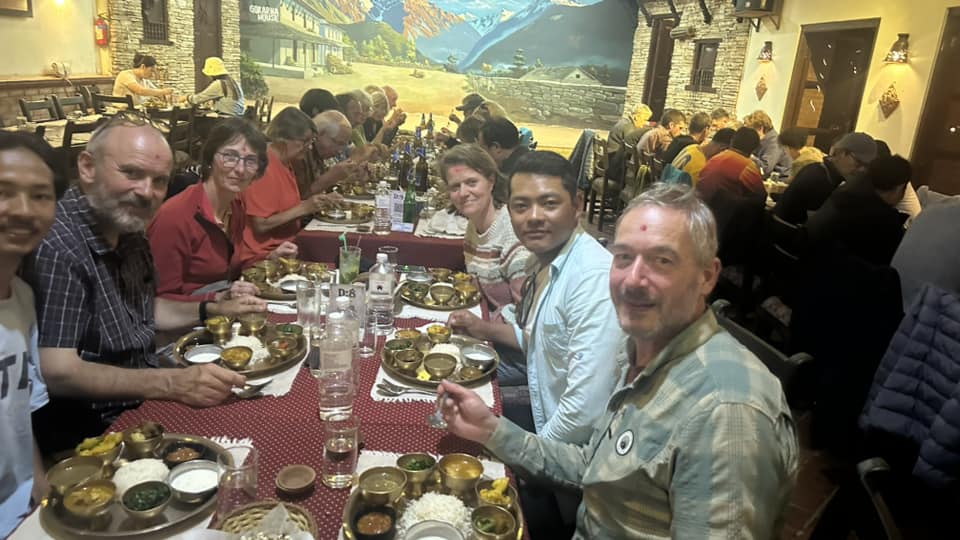
For breakfast, you should anticipate dishes like bread, eggs, puddings, cornflakes, pancakes, oats, soups, congee, jam bread, muesli, paratha, Sel-roti, puri andTarkari, and so on.
For breakfast and dinner, you can anticipate dishes like Daal Bhaat Tarkari, Thakali khana set, Gundruk Dhindo, Rildok, Thukpa, Tingmo, pizza, momo, chow mein, spaghetti, etc.
Additionally, a wide range of beverage options are available. You can have a variety of hot, cold, and hard drinks on your hike to Annapurna base camp, including freshly squeezed juices. Hard drinks, on the other hand, may interfere with your acclimatization process and increase the difficulty of your walk, thus you should avoid them.
Precautions and Safety Measures
Stay Hydrated
March is typically not as hot as summer, so you might not perspire as much. In this case, your body’s water content might not drop as quickly, and you could think that drinking water is unnecessary. But you need to drink three to four liters of water a day, and you should stay hydrated throughout the day.
Be Aware of Altitude Sickness
As you go to a greater altitude, it’s common to experience altitude sickness. Therefore, you should not disregard discomfort-causing symptoms, such as headache, loss of appetite, dyspnea, or insomnia. As soon as possible, let the advisors know about your symptoms so they can assist you as soon as possible.
Travel Insurance
You are losing out on some of the most important things if you are trekking to Annapurna Base Camp without purchasing an insurance policy. During the hike, incidents and accidents of any kind are possible.
Secure comprehensive travel insurance covering medical bills, air ambulance, hospital expenses, evacuation, and cancellation fees. Mitigate risks and share costs for unexpected events and sudden cancellations.
Considerations While Trekking
When you climb in March to reach Annapurna Base Camp, you should consider the area’s environmental safety.
Because mountain locations are typically delicate, follow the adage “Leave no trace” and properly dispose of your garbage in the specified dustbins or dumping site. Additionally, you should avoid engaging in any actions that can harm the Annapurna region’s flora and fauna environment.
Hunting and animal killing are strictly prohibited. Additionally, since you do not know the habits of wild animals and birds, do not attempt to approach them if you see them.
You can also make an effort to show respect for the local customs and culture. Try picking up a few words or phrases in the native tongue to demonstrate your sincere desire to communicate with them.
Tips for Annapurna Base Camp
- Keep some basic prescriptions on hand.
- Having porters and guides with you is preferable.
- Trekking in a group is more comfortable than trekking alone.
- Don’t disregard any AMS symptoms.
- Keep a journey map with you.
- Remain vigilant and mindful.
- Get moving early in the morning.
FAQs Regarding the Annapurna Base Camp Trek in March
What month is suitable for the Annapurna base camp trek?
While there is year-round access to the Annapurna Base Camp Trek, the best seasons to explore the Annapurna region are spring (March to May) and fall (September to November).
How are the Annapurna base camp trek and the Annapurna circuit trek different?
While the Annapurna base camp trip travels over more varied terrain, the Annapurna circuit route does not. The highest point of the Annapurna circuit trek is 5,416 meters at Thorung La Pass.
The highest point on the ABC route is 4,130 meters at the Annapurna base camp.
What is the cost of the Annapurna base camp trek in March?
Depending on the schedule and highlights you select, the total cost of the Annapurna base camp hike may change. Nonetheless, the cost per person often falls between $700 and $1500.
Which trek is better to do in March, the Everest Base Camp trek or the Annapurna Base Camp trek?
In Nepal, both treks are popular trekking routes. With the piercing Himalayan mountains encircling them, both trekking routes are excellent choices for springtime trekking, which begins in March.
It is best to start with the Annapurna base camp trip if you are in experienced, and then move on to the Everest base camp once you have gained some experience at higher altitudes. If you are a seasoned hiker, climbing will be simple for you, so you can make your own decision.


